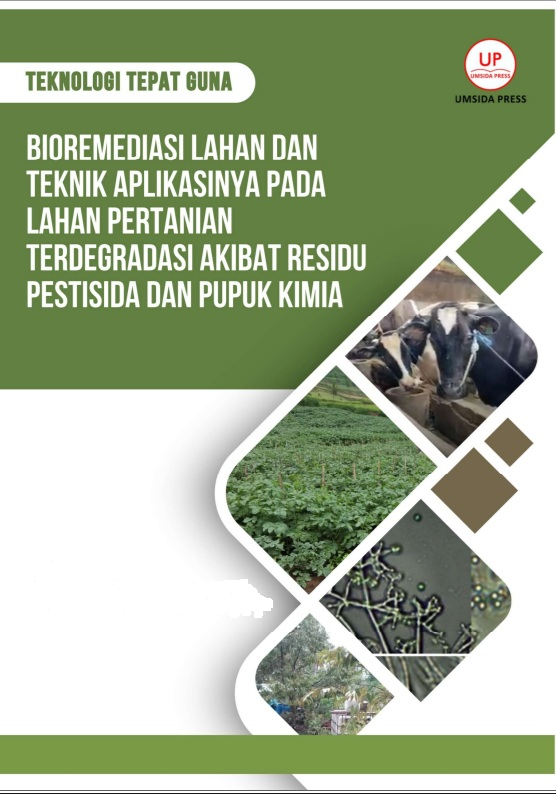Teknologitepat Gunabioremediasi Lahan Dan Teknik Aplikasinya Pada Lahan Pertanian Terdegradasi Akibat Residu Pestisida Dan Pupuk Kimia
Keywords:
Bioremediasi Lahan, Degradasi Tanah Pertanian, Residu Pestisida dan Pupuk KimiaAbstract
Judul : Teknologitepat Gunabioremediasi Lahan Dan Teknik Aplikasinya Pada Lahan Pertanian Terdegradasi Akibat Residu Pestisida Dan Pupuk Kimia
- BAB I: PENDAHULUAN
- BAB II: KONSEPSI DAN ANALISIS EKONOMI BIOREMEDIASI
- BAB III: KEBIJAKAN RELEVANSI DAN KENDALA
- BAB IV: IMPLEMENTASI BIOREMEDIASI
Editor: M.Tanzil Multazam
Published by:
Universitas Muhammadiyah Sidoarjo Press, Sidoarjo, 2025
ISBN:
- ISBN :
Deskripsi :
Teknologi Tepat Guna (TTG) bioremediasi lahan merupakan pendekatan berbasis organisme hidup—seperti mikroba, jamur, dan tanaman tertentu—yang digunakan untuk menguraikan, menetralkan, atau menghilangkan residu berbahaya dari pestisida dan pupuk kimia pada lahan pertanian. Degradasi lahan akibat penggunaan bahan kimia sintetis dalam jangka panjang dapat mengakibatkan penurunan kesuburan tanah, ketidakseimbangan mikrobiota, dan pencemaran lingkungan.
Fokus Utama :
Mengurangi residu pestisida dan pupuk kimia pada lahan pertanian terdegradasi melalui penerapan teknologi bioremediasi yang ramah lingkungan.
Meningkatkan kualitas dan kesuburan tanah (fisik, kimia, dan biologi) sehingga lahan kembali produktif dan aman untuk budidaya tanaman pangan.
Fitur Unik :
Menggunakan mikroorganisme lokal (indigenous microbes)
Mikroba berasal dari lingkungan setempat sehingga lebih adaptif, stabil, dan efektif dalam menguraikan residu pestisida serta pupuk kimia.
Target Audiens :
Petani dan Kelompok Tani
Pihak yang langsung merasakan dampak degradasi lahan dan merupakan pengguna utama teknologi bioremediasi.
Penyuluh Pertanian Lapangan (PPL)
Sebagai pendamping teknis yang akan meneruskan penerapan, edukasi, serta monitoring teknologi bioremediasi di tingkat desa.
Downloads
References
Ayilara, M. S., Ajay, S., & Ololade, I. A. (2023). Bioremediation of environmental wastes: The role of microbes and emerging approaches. Frontiers in Agronomy. https://doi.org/10.3389/fagro.2023.1183691
Badan Penelitian dan Pengembangan Pertanian. (2022).Laporan status kesuburan tanah sawah intensif di PulauJawa. Kementerian Pertanian Republik Indonesia.
FAO. (2025). Circular bioeconomy for sustainable agriculture:Policy and practice guidance. Food and Agriculture
Organization of the United Nations.
Kementerian Lingkungan Hidup dan Kehutanan Republik
Indonesia. (2022). Rencana Operasional FOLU Net Sink
2030. KLHK Publications Portal.
Nguyen, T. Q., Kumar, P., & Singh, R. (2024). Participatory
social analysis in sustainable land remediation.
Environmental Economics Review, 15(2), 134–150.
Rahman, M., Li, X., & Chen, Y. (2023). Microbial mechanisms
of pesticide degradation and soil detoxification. Applied
Soil Ecology, 189, 104723.
Sutarman. (2022). Identification of several Aspergillus isolates
candidates for biofertilizer agents using molecular
markers. IOP Conference Series: Earth and
Environmental Science, 1104, 012026.
https://doi.org/10.1088/1755-1315/1104/1/012026
Sutarman, Triana Setiorini, Arrohmatus Syafaqoh Li’aini,
Purnomo, & Ali Rahmat (2022) Evaluation of
Trichoderma asperellum Effect toward Anthracnose
Pathogen Activity on Red Chili (Capsicum annum L.) As
Ecofriendly Pesticide. International Journal of
Environmental Science and Development, 13(4), 131-137,
DOI: https://doi: 10.18178/ijesd.2022.13.4.1383
Modul Pelatihan TTG – PDB GEDRO KEC TUTUR-PASURUAN 30
Sutarman, A. E. Prihatiningrum, & A. Miftahurrohmat. (2023).
Application of Trichoderma and Aspergillus as
biofertilizers in eco-friendly ratoon rice cultivation. Asian
Journal of Agriculture and Rural Development, 13(4),
277–287. https://doi.org/10.55493/5005.v13i4.4934
Sutarman, D. Prasetyo, L. Hudi, S. R. Nurbaya, Sriyono, &
Mulyadi. (2024). Potential of Trichoderma to improve
probiotic performance in Vannamei shrimp cultivation.
E3S Web of Conferences, 595, 02002.
https://doi.org/10.1051/e3sconf/202459502002
Sutarman, P. H. Tjahjanti, A. E. Prihatiningrum, & A.
Miftahurrohmat. (2022). Effect of Trichoderma
formulated with cultivated oyster mushroom waste
toward the growth and yield of shallot (Allium
ascalonicum L.). African Journal of Food, Agriculture,
Nutrition and Development, 22(10), 21743–21760.
https://doi.org/10.18697/ajfand.115.19965
Sutarman, P., A. E. Prihatiningrum, & A. Miftahurrohmat.
(2024). Effects of shade and Trichoderma on vegetative
growth response of upland rice to acid soil. African
Journal of Food, Agriculture, Nutrition and Development,
24(9), 24510–24525.
https://doi.org/10.18697/ajfand.134.24105
UNDP. (2023). Capacity development triangle: Framework for
sustainable community resilience. United Nations
Development Programme.
USEPA. (2022). Overview of in situ and ex situ bioremediation
technologies. United States Environmental Protection
Agency.

Published
How to Cite
License
Copyright (c) 2025 Sutarman, Hana Catur, Lilik, Mulyadi

This work is licensed under a Creative Commons Attribution 4.0 International License.
Authors retain copyright and grant the Umsida Press right of first publication with the work simultaneously licensed under a Creative Commons Attribution 4.0 International License that allows others to share the work with an acknowledgement of the work's authorship and initial publication in this platform.

